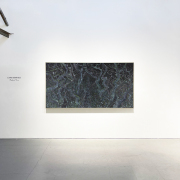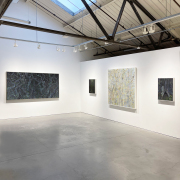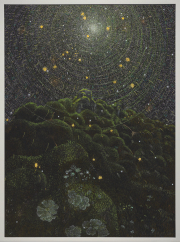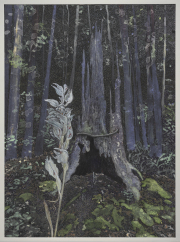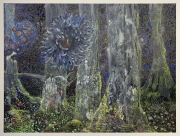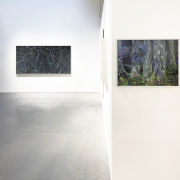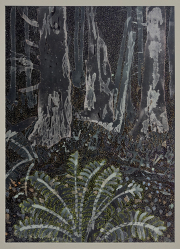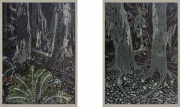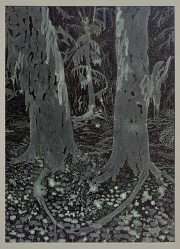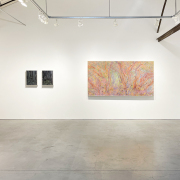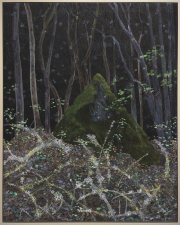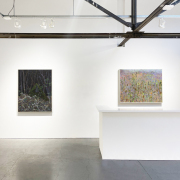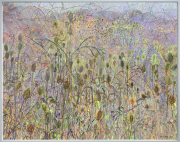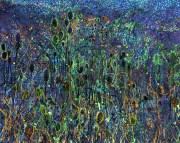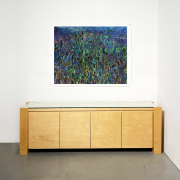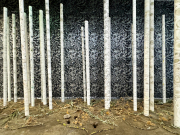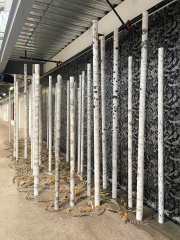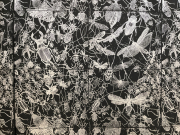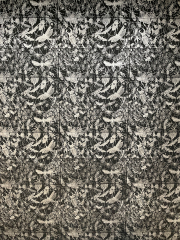.
.
.
Claire Burbridge
Peripheral Visions
August 14 to September 28, 2024
NANCY TOOMEY FINE ART
1275 Minnesota Street, San Francisco

Claire Burbridge, Dew Point, 2024, Japanese watercolor, ink, salt, 51 x 40.25 inches
Nancy Toomey Fine Art is pleased to announce an exhibition of works by Claire Burbridge titled Peripheral Visions on view from August 14 to September 28, 2024. The gallery is located inside San Francisco’s Minnesota Street Project, 1275 Minnesota Street. Gallery hours are Wednesday through Saturday, 12pm to 4pm, and by appointment–please contact nancy@nancytoomeyfineart.com or 415-307-9038.

Claire Burbridge, Viriditas, 2024, Japanese watercolor, ink, acrylics, salt, 48.25 x 91 inches
Essay by Emily Dara Shinn
Peripheral: the outside, surface, or superficial; the minor, inessential, or secondary.
Vision: the ability to perceive; eyesight, optics; conception, idea, insight.
Claire Burbridge captures the essence of earthly realms unseen, overlooked, and uncharted. Comprised of pigment, terrestrial ingredients, scientific inquiry, and an empathic will, her work balances gracefully between a challenge of perception and an encouragement to wonder. The title of this show, Peripheral Visions, illuminates a core tenet of the artist’s practice and ethos: there is much to discover at the edges of our senses, and a significance to all things in the natural world. Each piece on view is a reminder that the periphery is not what a standard definition would imply. As Burbridge shows us, opening our senses to the peripheral is a means of getting closer to the essential, the unifying, the whole.
Surrounded by the rich landscapes of Southern Oregon, the subject matter Burbridge gravitates to is informed by what she describes as “sacred spots”–dynamic mountain forests, fecund backyard gardens, and familiar neighborhood trees. Though intricately detailed and conscientiously attuned to authenticity, realistic plant portraiture is not the goal. “The pieces are a platform for me to express how I am affected and transformed by being there, a state of continuous communion with the atmosphere of these places, so familiar to me,” she explains. Transformation is key to the works on view. Materializing her process, they display evolutions in her experience and perception, emulating the transformative cycles in nature that inspire her.

Claire Burbridge, Unified Field, 2022, Japanese watercolor, inks, salt, 60.25 x 59.75 inches
Beginning in 2022, with the Unified Field series and continuing with the works that give the title to this exhibition, Burbridge experimented with softening her vision and cultivating an increased awareness of an entire field of vision, bringing periphery to the center. This allows a visual reflection of what she refers to as “the life force” within the environment and provides equal space for multiple sensations and modes of vision. No detail is more important than another. With her signature holistic approach, Burbridge illustrates an overlooked truth of the natural world that “everything is of equal importance.”

Claire Burbridge, Forest Elegy, Yupo paper, salt watercolor, ink, (installation), and Insects, screen printed wallpaper
Forest Elegy brings a physical manifestation of trees to the gallery’s building atrium with an arboreal field commemorating devastating fires near Burbridge’s home in 2020, forever changing some of her sacred walking spots. Incorporated into pigment, bits of ash animate the paper bark as a reminder of how life and death are indistinguishably linked in nature. Trees ravaged by human life and disasters still breathe within their burnt exterior and give back to the earth even as they surrender to decay. Burbridge creates a physical moment of silence for these entities and this process, so easily moved to the periphery of busy lives after danger recedes.

Claire Burbridge, Nocturne 1 and 2, 2023, watercolor, salt crystals, 20.75 x 15.25 inches (each)
In addition to lichen and ash, salt plays a physical and symbolic role in Burbridge’s works. The artist partially dissolves salt crystals into the watercolor pigments that act as a bedrock to her exquisitely intricate ink and pencil drawings of forest life. The ethereal radiance of Elfin Forest and Nocturne 1 and 2 emerges from the physical elements and foundational processes of the earthen landscapes represented. Chemically, salt is a hygroscopic substance: it attracts and pulls in as much liquid as possible. Each crystal planted by Burbridge acts like a magnet to the saturated pigment. As water absorbs, salt dissolves and remains in spontaneous reactions that create new domains of texture and visual appeal.
The approach requires the artist to loosen her perfectionism and allows for a more organic depiction of her subject. “I find it more truthful. More immediate.” She explains. “It means I can’t just rely on representing something as it is. My feelings can be conveyed more honestly through this life-filled medium.” In Burbridge’s careful hands, the additional material blends seamlessly with her signature pointillist technique to create tangible constellations of color and light–a mythic glimpse of earth that truly glitters.

Claire Burbridge, Forest Apparitions, 2023, pigment pencil, watercolor, ink, salt, 20 x 26 inches
Watercolor is an ideal foundation not only for the artist’s earthen materials, but for expressing the practice of softened vision. The illusory trees populating Forest Apparitions take inspiration from the effects that nightfall can have on our perception and the mechanisms with which we interpret what we see. “Does the dark reveal a different world of unseen nature, undiscovered and unknowable in daylight?” asks Burbridge. Washes and glazes of diluted pigment give life to a faery forest on the edge of visibility. Ancient root systems glow through mossy ground cover and fertile plant life; incandescent bark merges with friendly fungi; phantasmic flowers bloom among the stars. Is it an apparition, or just another perspective?

Claire Burbridge, Fluorescence, 2024, Japanese watercolor, ink, acrylics, salt, 40.25 x 50.75 inches
In each work, Burbridge asks us to question how we interpret significance in the organic matter around us and perceive our part in the living relationships that comprise our world; how we see, metaphorically and literally. Florescence and Viriditas (vitality, lushness) ask these questions on a grand scale through fluorescent paints and pens accentuated with black light. The ultraviolet bulbs emits shorter wavelengths than the light spectrum visible to humans, activating photons in the paint and creating a reaction that increases the wavelength of light emitted back to us to produce a shift in visible color.

Claire Burbridge, Fluorescence (Black Light Version), 2024, archival digital print, 44 x 56.5 inches, edition 1 of 11
The chemical response in the paint mimics the fluorescence process of many plants and fungi when captured by UV photography. Short wavelength light spectrums are also a tool used to understand how insects and birds might see, navigating the same world as humans through a mode of vision inaccessible to us without aid. Natural light and the human-visible light spectrum are still important, this is not a contest of value. The black light, as Burbridge explains, “gives another dimension and reminds us that it was there all along and just a shift in light frequency (or consciousness) revealed this layer hidden in plain sight.”

Claire Burbridge, Lunaria, 2024, pigment pencil, ink, acrylics, 28.25 x 20.75 inches
Recently completed drawings endeavor to open this hidden layer with the aid of pigment pencils and Japanese watercolors, which offer more intense concentrations of color. Seeds of the Salsify plant–a flowering edible root–ride concentric air currents in Lunaria, casting a radiance that seems to challenge the perceived niche significance of the nourishment and medicinal qualities contained within the mature plant’s unassuming exterior. The title of primordial vision receives inspiration from the unique Lunularia species of the otherwise common Liverwort, one of the smallest plants on earth. Akin to moss, Lunularia nests close to the ground and thrives in damp, shaded environments. The seemingly ornamental crescent-shaped cups covering its surface (inspiring its name–“Luna” referring to a crescent moon) are essential to its survival and key to its beauty. Reproductive tissue called gemmae develop within the crescents. When jostled by rain, the gemmae disperse in the nearby environment and take root. Lunularia reproduces as needed: asexually through gemmae in damp environments, or in arid environments through fertilizations of spores that will disperse and find access to water. Diminutive and underfoot, these easily overlooked symbiotic reproductive ballets exemplify the exquisite versatility and adaptability at the heart of the natural world.

Claire Burbridge, Phantom Orchid, 2024, Japanese watercolor, ink, salt, pigment pencils, 28.25 x 20.75 inches
Phantom Orchid shows the pale presence of a flower native to the rich soil of the Pacific Northwest, encountered by Burbridge in mountain walks on Green Springs Loop Trail outside of Ashland. Almost pure white, these quiet flowers have no chlorophyll and are unable to perform photosynthesis. Instead, they depend on a genus of Thelephorales fungi and surrounding trees to acquire nutrients. A rare sight due to its talent of lying dormant for over a decade between blooms, this ghostly flower is a visible reminder for the invisible processes at work all around us and the links of cooperation integral to survival.
Through hand, heart, and an intuitive embrace of sensory life, Burbridge interprets plants and trees as self-described “vehicles to express what is beyond or at the edges of our vision and other senses…a unity of all things seen and unseen.” Each work invites us to recognize that breadth of awareness and willingness to seek new views is the root of our place in the world, our understanding of it, and our ability to commune with it. Because it is ever-present and available for communion if we just look.

Claire Burbridge, photo by Matthew Picton
Claire Burbridge currently lives and works in Ashland, Oregon. Burbridge was born in London in 1971, and gained her bachelor’s degree in Fine Art and the History of Art at Magdalen College Oxford and the Ruskin school of Fine Art in 1993. After completing a master’s in Fine Art printmaking at Camberwell College of Art and Design, she lived and worked as a practicing artist in London until 2010 when she relocated to southern Oregon. Her work is included in many private and public collections worldwide, notably the Huntington Museum of Art in West Virginia, Ashmolean Museum in Oxford, and the Fidelity Bank Collection in Cincinnati. After her 2020 solo exhibition Pathways to the Invisible at the Jordan Schnitzer Museum of Art in Eugene, she was commissioned by the Oregon Arts Commission to do a large series of works, now permanently installed at Western Oregon University’s Natural Sciences building.
Peripheral Visions is Claire Burbridge’s sixth solo show at Nancy Toomey Fine Art in San Francisco.
